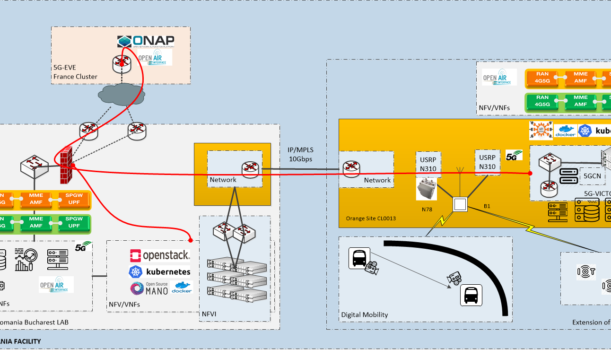5G aims to provide higher capacity and lower latency, as well as an increased level of programmability, control, and flexibility to meet the requirements stemming from innovative use cases from various vertical sectors. 5G requires dynamic allocation of resources, flexible deployment of functions in distributed cloud infrastructures and, at transport level, the embedding of the required end-to-end control and data plane connectivity between software peer entities and terminals, across the physical network.
Network operators have an extensive knowledge on testing and validation in communication networks and must address efficiently high financial and time costs associated with testing new hardware and software. There is an increased attention towards the area of 5G Network Applications, where it has become necessary to shorten the cycles between development, testing and production. Automated tools and processes are of high demand for proof of concept, acceptance, regression testing and validations processes, keeping costs relatively low, while having access to certification processes.
To address these requirements the 5GASP focuses on the integration of multiple tiered-level designs, exposing and enabling automated testing and certification of key execution steps for Network Applications. Additionally, a workflow for testing of Network Applications in multiple configurations and testbeds will be developed.
A key objective to achieve such goals is to make available virtual machines as well as containerized platforms. In terms of NFV, all 5GASP testbeds follow the ETSI NFV reference architecture offering the two most-known solutions of OSM and ONAP, while supporting both modelling and packaging according to the ETSI standards OSM/SOL006 (YANG model) and ONAP/SOL001 (TOSCA). In terms of the overall 5G system, 5GASPs’ facilities offer 5G New Radio and 5G Systems supporting both 5G NSA and 5G SA, while various MEC solutions are available. An improvement is related to the onboarding time of the virtual machine’s images or containers to a facility. This is the most time-consuming process, which will be reduced with pre-loading or caching mechanisms.
In terms of orchestration tools, ONAP is used, but in the larger scope of the 5GASP project OSM will also be considered. Albeit there are certain specific functionality differences, both solutions address the requirements. The facilities used for testing and validation also have IaaS/CaaS capabilities, such as those provided through the usage of Openstack and K8s.
The approach used for one of the facilities involved in the 5GASP project is to have the MEC servers and apps collocated with dedicated user plane core network. This is used to bring user plane network functions closer to the end-user and because it is platform-independent from the rest of the network exposing its own virtualization or containerization environment, with tools and set of standardized APIs both for services and lifecycle management.

A V-model methodology can be used for testing, as shown in the diagram below. This end-to-end model demonstrates the relationships between each phase of the development and onboarding life cycle, as well as its associated phase of testing. On the horizontal and vertical axes are represented time or project completeness and level of abstraction, respectively.

In this manner, the Network Application requirements are firstly setup, to transform the Network Application to a set of virtual functions that can have an automated repeatable deployment and testing cycle. Then, the Network Applications are developed and adapted for orchestration by the facilities NFV orchestrators. After this, the Network Applications are on-boarded to catalogues and prepared to be orchestrated and tested by the CI/CD cycle.
The Network Application onboarding to target facility phase is performed automatically and the Network Application is orchestrated to target experimentation and testing facilities. Several testing phases follow, before the Network Application is published to the shared marketplace.


